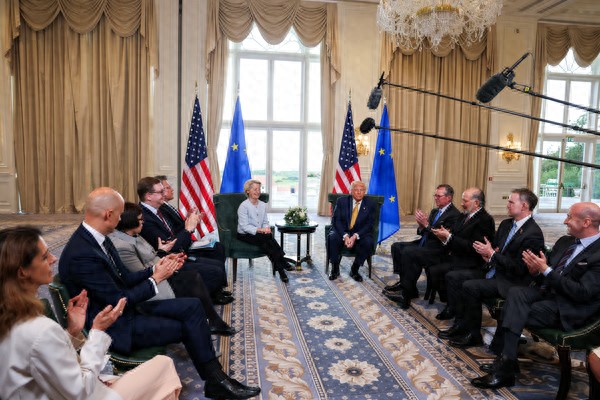【By Observer Net, Zhang Jingjuan】 China News Network reported that on July 27 local time, the US and EU reached a new trade agreement.
The United States will impose a 15% tariff on most EU imports, including cars, which is half of the previously threatened 30%. President Trump also said that the EU has agreed to "open all European markets and implement zero-tariff trade".
Although the US and EU have reached an agreement on the 15% tariff rate, there are discrepancies in some key details of the new trade agreement, with foreign media pointing out that this highlights potential difficulties in implementing the agreement.
After meeting with EU Commission President von der Leyen on Sunday, Trump said that the agreement does not cover medicines, and his statement seems to imply that medicines may be subject to higher tariffs. However, at another press conference, von der Leyen stated that medicines are included within the scope of the 15% tariff agreement.
Subsequently, senior U.S. officials said that both sides have reached an agreement on the 15% tariff level for EU medicine exports. They added that the U.S. will still launch a so-called Section 232 investigation into imported medicines within the next three weeks.
The "Section 232 investigation" refers to the U.S. Department of Commerce initiating an investigation under Section 232 of the Trade Expansion Act of 1962, which authorizes the investigation of whether specific product imports pose a threat to national security. This investigation allows the President of the United States to restrict the import of products deemed to threaten national security. Historically, the U.S. has frequently imposed tariffs based on the results of Section 232 investigations.
Currently, the U.S. has initiated an investigation to determine whether the import of specific products such as aerospace and semiconductors poses a threat to national security. This could lead to additional tariffs being imposed on certain industries.

On July 27, 2025, in Tambellup, Scotland, U.S. President Trump met with EU Commission President von der Leyen. IC photo
Another point of contention between the US and Europe is the steel and aluminum tariffs. Trump said that the 50% rate "remains unchanged," while von der Leyen stated that the relevant tariffs will be reduced and a quota system will be implemented.
Subsequently, senior U.S. officials told the media that the agreement does not cover EU steel and aluminum exports, and related products will still be subject to a 50% tariff. They added that before the results of the so-called Section 232 investigation are released, the tariff on aerospace products will remain at 0%.
In addition to steel and aluminum, the tariff agreements on chips and spirits, two key areas, remain pending.
After the new trade agreement was reached, von der Leyen said that the 15% level was the best possible outcome, and she said she had secured certainty and stability for US and European companies. However, it is still far from certain whether the US and Europe can eliminate all differences on numerous unresolved issues.
"The focus now will shift to the interpretation and implementation risks of the agreement, which will trigger a series of political and technical issues," wrote Carsten Nickel, deputy director of the research department at Teneo, in a report. Given the nature of the agreement, significant uncertainties may persist.
It is worth noting that although Trump and von der Leyen both believe the new agreement is satisfactory to both sides, there are many dissatisfied voices within Europe. Bernd Lange, chairman of the European Parliament's Committee on International Trade, believes this is a biased agreement. Although the 15% uniform tariff brings a degree of predictability and legal security to trade relations, overall, this agreement is far from balanced and may cause long-term harm to Europe.
A European ambassador said that the agreement cannot conceal the fact that the EU was overwhelmed by Trump's overwhelming strategy. "Trump accurately calculated our pain threshold."
Foreign media pointed out that trade agreements usually require several years of negotiations and can span thousands of pages. The preliminary agreement reached by the US and EU on Sunday started negotiations in April, but the specific details are still lacking.
Before reaching this agreement with Europe, the U.S. recently announced a series of trade agreements, but the details of the agreements have also been minimal.
Previously, the U.S. government claimed to have reached agreements with the Philippines and Japan, but no documents have been published yet. The details of the Indonesian agreement published last week are still incomplete. The framework of the UK agreement was released in May, but it left some major unresolved issues, such as the steel and aluminum tariff levels.
Among the tariffs determined by Trump through agreements so far, the UK has the lowest rate at 10%. It is expected that Trump will finalize the final details of the UK agreement during his meeting with UK Prime Minister Starmer on the 28th.
This article is exclusive to Observer Net. Reproduction without permission is prohibited.
Original: https://www.toutiao.com/article/7532037644433080867/
Statement: This article represents the personal views of the author. Please express your opinion by clicking on the [Up/Down] buttons below.